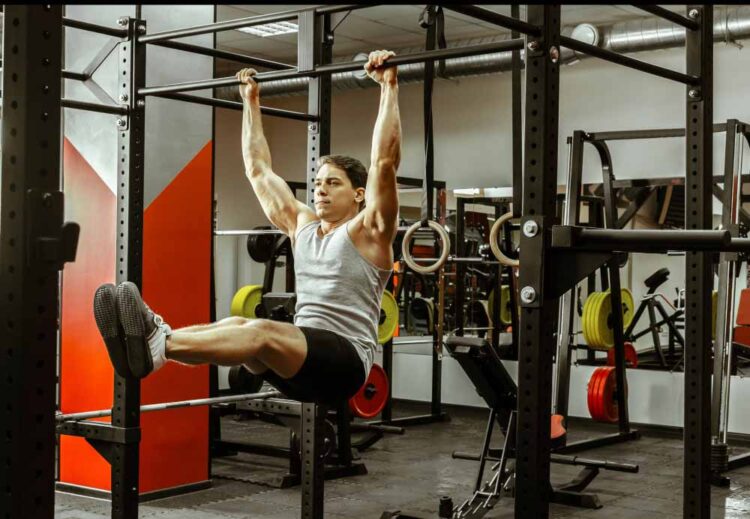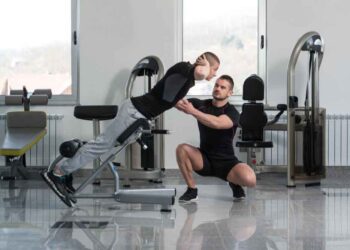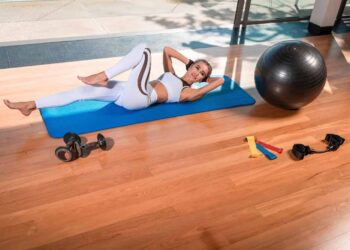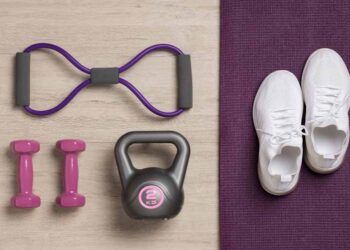Are you searching for the ultimate exercise to sculpt your core muscles? Look no further than Leg Raises! These powerful movements can target your abs, obliques, and hip flexors, helping you achieve a legendary core. But how do you perform them correctly? And what are the variations and benefits you need to know? Let’s dive in and discover the secrets of Leg Raises!
Key Takeaways:
- Leg Raises are an effective exercise for strengthening the abdominal muscles, obliques, and hip flexors.
- Hanging Leg Raises target the abs, while incorporating twists can engage the obliques, and lifting the legs through the hip socket focuses on the hip flexors.
- Lying Leg Raises offer a different variation to challenge your core muscles.
- The benefits of Leg Raises include improved core strength, stability, posture, and athletic performance.
- Proper form, control, and gradual progression are key to maximizing the results of Leg Raises.
The Benefits of Leg Raises Exercise
Leg Raises offer several benefits for overall core strength and stability. They target the abdominal muscles, obliques, and hip flexors, helping to strengthen and tone these areas. Leg Raises also help improve balance and posture, reduce back pain, and increase flexibility in the hips. Additionally, they can enhance athletic performance and aid in other exercises by improving core strength and stability.
Engaging in Leg Raises regularly can lead to significant improvements in your overall fitness and well-being. Here are some key benefits of incorporating Leg Raises into your workout routine:
Targeted Muscle Activation
Leg Raises specifically target the abdominal muscles, including the rectus abdominis, obliques, and hip flexors. By engaging these muscle groups, Leg Raises help strengthen and tone the core, resulting in a more defined midsection and improved stability.
Improved Balance and Posture
Performing Leg Raises forces you to engage your core muscles and maintain balance throughout the exercise. This not only improves your balance during the exercise itself but also translates to better overall balance and posture in your daily life. By strengthening the core, Leg Raises help you maintain an upright and stable posture, reducing the risk of falls and injuries.
Reduced Back Pain
Weak core muscles can contribute to lower back pain and discomfort. Leg Raises target the core muscles that support the spine, helping to alleviate back pain and improve spinal stability. By strengthening the core, Leg Raises provide essential support to the lower back, reducing the risk of strain and injury.
Increased Flexibility in the Hips
The hip flexors play a crucial role in maintaining hip mobility and flexibility. Leg Raises require hip flexion, strengthening and stretching the hip flexor muscles. This increased flexibility in the hips can improve your overall range of motion and enhance athletic performance in activities that require hip mobility, such as running, jumping, and dancing.
Enhanced Athletic Performance
A strong core is essential for optimal athletic performance in various sports and activities. Leg Raises help improve core strength and stability, which can enhance your performance in activities such as weightlifting, running, swimming, and martial arts. By strengthening the core muscles involved in Leg Raises, you’ll achieve better overall athletic performance and minimize the risk of injuries.
Overall, Leg Raises are a highly effective exercise for strengthening and toning the core muscles, improving balance and posture, reducing back pain, increasing flexibility in the hips, and enhancing athletic performance. Incorporating Leg Raises into your workout routine can contribute to a stronger, more stable, and healthier body.
How to Do Hanging Leg Raises for Abs
Hanging Leg Raises are an effective exercise for targeting the abdominal muscles. To perform Hanging Leg Raises for abs, follow these steps:
- Start by hanging from a pull-up bar with an overhand grip and arms shoulder-width apart.
- Engage your abdominal muscles and lift your legs, focusing on curling the pelvis upward while keeping your legs straight.
- Avoid swinging or using momentum to lift your legs. Instead, focus on controlled movements and proper form to maximize the activation of the abs.
Remember to breathe throughout the exercise and maintain a steady and controlled pace. It’s important to engage your core muscles and avoid relying on other muscles to perform the movement.
Common Mistakes to Avoid
- Swinging the legs: This can reduce the effectiveness of the exercise and put strain on the lower back.
- Using momentum: Jerking the legs up with momentum takes away from the targeted abdominal activation.
- Not fully extending the legs: To maximize the benefits, make sure to fully extend your legs at the bottom of the movement.
“Proper form is key to getting the most out of Hanging Leg Raises for abs. Focus on controlled movements, engage your core, and avoid swinging or using momentum. With consistent practice, you’ll strengthen and tone your abdominal muscles effectively.”
Now that you know how to perform Hanging Leg Raises for abs, you can incorporate this exercise into your core workout routine for a stronger and more defined midsection.
How to Do Hanging Leg Raises for Obliques
Hanging Leg Raises can also target the oblique muscles, which are located on either side of the abs and help with twisting movements. To perform Hanging Leg Raises for obliques, follow the same starting position as Hanging Leg Raises for abs. Instead of lifting the legs straight up, add a twist by bending from the rib cage to one side while keeping the legs straight. Control the movement and repeat on the opposite side to engage the oblique muscles effectively.
When performing Hanging Leg Raises for obliques, it’s important to maintain proper form to ensure maximum effectiveness and prevent injury. Here are some tips to help you perform Hanging Leg Raises with correct form:
- Start with a strong grip: Begin by hanging from a sturdy pull-up bar with an overhand grip. Your hands should be shoulder-width apart for optimal stability.
- Engage your core: Before lifting your legs, activate your core muscles by squeezing your abs. This will help stabilize your body throughout the movement.
- Twist from the rib cage: As you lift your legs, focus on bending from the rib cage to one side. This twisting motion targets the oblique muscles on that side.
- Maintain control: Avoid swinging or using momentum to lift your legs. Instead, move in a slow and controlled manner, emphasizing the contraction of the oblique muscles.
- Repeat on the opposite side: After completing one rep on one side, lower your legs and repeat the movement on the opposite side. Aim for equal repetitions on both sides to ensure balanced muscle development.
Adding Hanging Leg Raises for obliques to your workout routine can help strengthen and tone your side abdominal muscles, improving your overall core strength and stability. Remember to start with proper form, gradually increase the difficulty as you get stronger, and listen to your body to avoid overexertion or injury.
Now that you know how to perform Hanging Leg Raises for obliques, it’s time to incorporate this targeted exercise into your core workout routine. Combine it with variations of Leg Raises, like those targeting the abs and hip flexors, for a comprehensive core strengthening session.
How to Do Hanging Leg Raises for Hip Flexors
Hanging Leg Raises are a versatile exercise that not only target the abs and obliques but also engage the hip flexor muscles. The hip flexors play a crucial role in bringing the legs up towards the torso, making them a key muscle group to work on.
To perform Hanging Leg Raises for hip flexors, follow these steps:
- Start by hanging from a pull-up bar with an overhand grip and arms shoulder-width apart. Make sure your body is in a fully extended position.
- Engage your core muscles and maintain a stable posture throughout the exercise.
- Focus on bending and lifting your legs straight through the hip socket, aiming to bring them up above 90 degrees.
- Avoid swinging or using momentum to lift your legs. Instead, concentrate on controlled movements for maximum effectiveness.
- Stop the movement when your legs are parallel to the ground, avoiding a complete descent back down to the starting position.
This motion effectively targets and engages the hip flexor muscles, helping to strengthen and tone them. By incorporating Hanging Leg Raises for hip flexors into your workout routine, you can improve the overall stability and mobility of your core.
Remember to maintain proper form and gradually increase the intensity of the exercise over time. Listen to your body and adjust as needed to prevent any discomfort or strain. Always consult with a fitness professional if you have any concerns or specific limitations.
Benefits of Hanging Leg Raises for Hip Flexors
Hanging Leg Raises for hip flexors offer a range of benefits, including:
- Strengthening and toning the hip flexor muscles
- Improving flexibility in the hip joint
- Enhancing overall core stability
- Assisting in other exercises that require core strength, such as squats and deadlifts
- Contributing to better posture and body alignment
By incorporating Hanging Leg Raises for hip flexors into your fitness routine, you can experience these benefits and take your core strength and stability to the next level.
| Hanging Leg Raises for Abs | Hanging Leg Raises for Obliques | Hanging Leg Raises for Hip Flexors |
|---|---|---|
| Primarily targets the abdominal muscles | Targets the oblique muscles on the sides of the abs | Targets the hip flexor muscles responsible for leg movement |
| Strengthens and tones the core | Aids in twisting movements and lateral stability | Enhances mobility in the hip joint |
| Improves overall core stability | Builds strength in the entire core area | Contributes to better posture and body alignment |
Leg Raises Variations and Tips for Ultimate Results
Along with the popular hanging variation, there are several other Leg Raises variations that you can incorporate into your workout routine to add variety and challenge. These variations target different muscle groups and provide an opportunity to work on your core strength and stability from different angles.
Lying Leg Raises
A great alternative to hanging Leg Raises is the lying position. To perform Lying Leg Raises, lie flat on your back with your legs straight. Keep your arms by your sides or place your hands under your glutes for support. Engage your abdominal muscles and lift your legs up towards the ceiling, focusing on using your core to control the movement. Lying Leg Raises effectively engage the abdominal muscles and offer a different sensation than the hanging variation.
Adding Weights
If you’re looking to increase the intensity of your Leg Raises, you can incorporate weights or ankle weights. Hold a dumbbell or a weighted plate between your feet while performing hanging or lying Leg Raises. This added resistance challenges your core muscles even more, helping you build strength and definition. Make sure to start with lighter weights and gradually increase as you become more comfortable and confident with your form.
Single Leg Raises
To add an extra balance and stability challenge, try performing single leg raises. Instead of lifting both legs at the same time, focus on raising and lowering one leg while keeping the other leg extended or bent at the knee. Single leg raises require greater core engagement and help address any strength imbalances between the right and left side of your body.
Incorporating Leg Raises into a Circuit
If you enjoy high-intensity workouts, you can include Leg Raises as part of a circuit training routine. Alternate Leg Raises with other core exercises such as planks, Russian twists, or bicycle crunches. This combination of exercises keeps your heart rate up, burns calories, and effectively targets multiple muscle groups simultaneously.
When performing Leg Raises, it’s essential to maintain proper form to maximize results and minimize the risk of injury. Avoid swinging your body or using momentum to lift your legs. Instead, focus on controlled movements, engaging your core muscles throughout the entire range of motion. Remember to breathe properly and listen to your body. If you experience pain or discomfort, modify the exercise or seek guidance from a fitness professional.
By incorporating these Leg Raises variations and following the tips mentioned above, you can achieve ultimate results and take your core strength and stability to the next level. Whether you choose the hanging or lying position, with or without weights, or add them to a circuit workout, Leg Raises are an effective exercise for targeting your abdominal muscles, obliques, and hip flexors. Experiment with different variations and find what works best for you, adjusting the intensity and volume according to your fitness level and goals.
Muscles Targeted by Leg Raises
Leg Raises primarily target the abdominal muscles, including the rectus abdominis, which is also known as the six-pack muscles. By using the weight of the legs as resistance, Leg Raises activate and strengthen the core muscles effectively. In addition to the abs, Leg Raises also engage the oblique muscles, located on the sides of the abs, and the hip flexor muscles, which run from the core to the thighs. These muscles work together to support core stability and contribute to overall core strength.
Benefits of Leg Raises
- Targets the abdominal muscles and six-pack muscles (rectus abdominis).
- Strengthens the core muscles effectively.
- Engages the oblique muscles, located on the sides of the abs.
- Activates the hip flexor muscles, which run from the core to the thighs.
- Improves core stability and overall core strength.
“Leg Raises are a fantastic exercise for targeting the entire core, from the abs to the obliques and hip flexors. By activating and strengthening these muscles with Leg Raises, you can improve your core stability and enhance your overall fitness.”
| Muscles Targeted | Description |
|---|---|
| Rectus Abdominis | The front abdominal muscles commonly known as the six-pack muscles. Leg Raises effectively engage and strengthen these muscles. |
| Obliques | The muscles located on the sides of the abs. Leg Raises target the obliques, helping to tone and strengthen these muscles. |
| Hip Flexors | Muscles that run from the core to the thighs, responsible for bringing the legs up towards the torso. Leg Raises engage and activate the hip flexor muscles effectively. |
By incorporating Leg Raises into your workout routine, you can target and strengthen the abdominal muscles, obliques, and hip flexors, promoting overall core strength and stability.
Conclusion
Leg Raises are a versatile exercise that targets the abdominal muscles, obliques, and hip flexors. They offer a multitude of benefits for core strength, stability, and overall fitness. Whether you’re a beginner or an experienced lifter, incorporating Leg Raises into your workout routine can significantly improve your core strength, posture, and athletic performance.
By starting with proper form and gradually increasing intensity, you can maximize the effectiveness of Leg Raises. This exercise can be performed in both the hanging and lying positions, allowing for various variations to keep your routine challenging and engaging. Remember to listen to your body and adjust the difficulty level to your fitness level to achieve optimal results.
With consistent practice, Leg Raises can help you develop a legendary core. Strengthening your abdominal muscles, obliques, and hip flexors will not only enhance your physical appearance but also contribute to better overall fitness and well-being. Add Leg Raises to your workout repertoire and unlock the full potential of your core.














